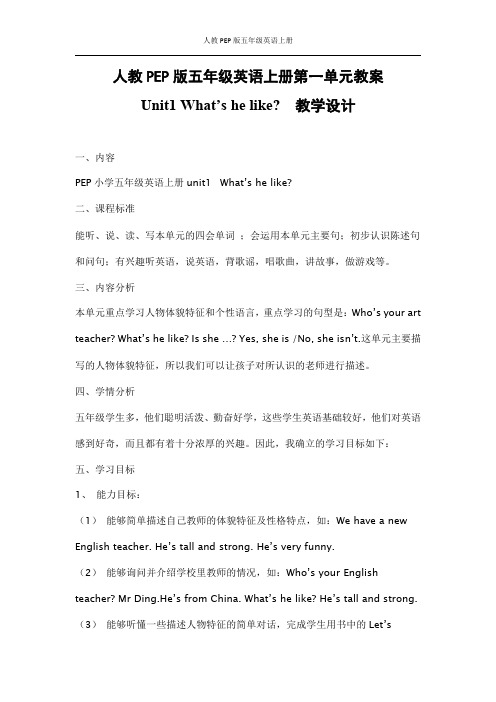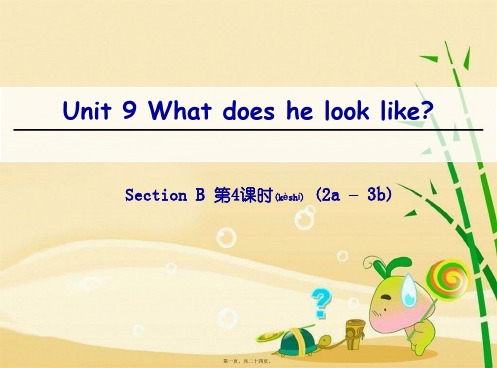Unit9《People》lesson 34 what’s he like课件(北师大版七年级下)
- 格式:ppt
- 大小:3.63 MB
- 文档页数:14

Unit 9 People一. 教学内容:Unit 9 PeopleLesson 33 What does he look like?Lesson 34 What’s he like?二. 教学目标学习对人的外表描述的表达方式和词汇了解如何描述体型学习如何描述人的性格三. 重点难点Lesson 33 What does he look like?I. Words Study 单词学习painter design character detective build thin long wavy blond curly ordinary-lookingin one’s fifties neighbor glasses slim lengthII. Expression Patterns 常用的表达方式1. 对人的外表描述的表达方式:What does he look like?He’s tall.He has black hair and blue eyes.(1)like的用法:<1>v. 作为动词,是“喜欢、喜爱”的意义a. -Which color do you like ? The red one or the blue one ?-I like the blue one.红色和蓝色,你喜欢哪种颜色?我喜欢蓝色。
b. -Do you like your cat ?-Yes . I do . And I love it very much .你喜欢你的猫吗?是的,很喜欢。
而且我非常爱它。
Note:注意like“喜欢”与love“爱,热爱”的区别。
前者感情较浅,后者感情深。
a. I like my cousin , but I don’t love him.我喜欢我的表哥,但我并不爱他。
b. I like playing ping-pong , but I don’t love it我喜欢打乒乓球,但我并不热爱这项运动。

人教PEP版五年级英语上册第一单元教案Unit1What’s he like?教学设计一、内容PEP小学五年级英语上册unit1What’s he like?二、课程标准能听、说、读、写本单元的四会单词;会运用本单元主要句;初步认识陈述句和问句;有兴趣听英语,说英语,背歌谣,唱歌曲,讲故事,做游戏等。
三、内容分析本单元重点学习人物体貌特征和个性语言,重点学习的句型是:Who’s your art teacher?What’s he like?Is she…?Yes,she is/No,she isn’t.这单元主要描写的人物体貌特征,所以我们可以让孩子对所认识的老师进行描述。
四、学情分析五年级学生多,他们聪明活泼、勤奋好学,这些学生英语基础较好,他们对英语感到好奇,而且都有着十分浓厚的兴趣。
因此,我确立的学习目标如下:五、学习目标1、能力目标:(1)能够简单描述自己教师的体貌特征及性格特点,如:We have a new English teacher.He’s tall and strong.He’s very funny.(2)能够询问并介绍学校里教师的情况,如:Who’s your English teacher?Mr Ding.He’s from China.What’s he like?He’s tall and strong.(3)能够听懂一些描述人物特征的简单对话,完成学生用书中的Let’stry部分。
(4)能够听懂、会唱歌曲“My New Teacher”.能够灵活替换歌词中的科目及表示人物特征的形容词。
2、知识目标(1)理解A、B部分Read and write中的会话,并根据提示填充句子或回答问题。
(2)听、说、读、写A、B部分Let’s learn和Read and write中的四会单词和句子。
(3)理解Let’s start、Let’s find out、Let’s sing、Let’s chant和Pair work 等部分的内容。


第三课时Section B (1a—1e)教学目标通过本课的学习,学生能够:1.获取和梳理本课时听力对话语篇中的关键信息;理解并掌握本课时重点词汇、句型,激发学习兴趣。
(获取信息)2.运用本课时重点句式进行操练和听力练习,学会描述外貌。
(梳理整合)3.运用输入的话轮结构进行语言输出,夯实重点句型。
(内化应用)4.正确描述自己最喜爱的人物的外貌,培养善于归纳总结的逻辑思维能力和对所学知识的结构化和系统化。
(迁移创新)语篇研读What:本课语篇是关于外貌的话题,通过两个孩子谈论自己喜欢的明星让学生进一步感知描述外貌的词汇如身高、体型、脸型、五官、头发、胡子等。
Why:根据“人与社会”主题范畴来设计听说课的教学目标和教学要求,依据目标和教学要求设计基于“外貌”的主题教学活动。
在对话过程中通过两个学生描述自己喜欢的明星的外貌,让学生了解描述外貌的词汇。
How:语篇采用听力对话形式呈现,对话部分有7个话轮,展示了两个学生喜欢的明星的外貌特征。
该语篇比第一课时的语篇内容更复杂,表达的更加深入和细致。
学生通过该语篇了解了更多话题内容。
教学过程设计理念:以《英语课程标准》核心素养为导向,以单元主题为引领,基于语篇的育人理念,体现《英语课程标准》“学思用创”的英语学习活动观和“教—学—评”一体化设计理念。
续表板书设计作业设计基础型作业: Recite the conversation in 1c.实践型作业:Describe what your favorite singer or athlete looks like. 拓展型作业:Draw a mind map and try to retell the passage.教学反思。

第四课时Section B(2a—3b)教学目标通过本课的学习,学生能够:1.获取和梳理本课时语篇中的what、how、why等关键信息;理解并掌握本课时重点词汇、句型。
(获取信息)2.掌握文本信息的处理能力,提高交流与合作能力。
(梳理整合)(内化应用)3.借助小组流动和探究,培养语篇分析能力及人际交往意识。
(迁移创新)语篇研读What:本课语篇通过描述画像师的职业和经历,学生真切地感受到外貌描述在生活中的实际用途,该文本在巩固人物描述的语言结构的同时,还考查了不同代词的指代对象。
Why:通过文本的阅读,一方面对学生进行思维结构的训练,让学生在理解语篇的基础上选出符合罪犯的人物形象。
另一方面,指示代词的考察,不仅考查学生对细节的理解,而且培养了学生的语篇分析能力。
How:文体为记叙文,在对画像师的职业和经历的描述中,巩固关于人物外貌的语言描述的同时,更注重培养学生思维和分析能力。
教学过程设计理念:以《英语课程标准》核心素养为导向,以单元主题为引领,基于语篇的育人理念,体现《英语课程标准》“学思用创”的英语学习活动观和“教—学—评”一体化设计理念。
教学目标学生活动效果评价Lead-in通过视频欣赏导入本课话题1.Greeting.2.The teacher asks students to watch avideo.3.The teacher asks students to look atthe picture and answer the questions.Q1:What is the policeman doing?Q2:What do you think of his job?4.The teacher asks students to look atthe picture and try to describe thepeople.观察学生能否根据图片观察回答问题和描述人物特征设计意图通过播放视频组织教学,提醒学生要集中精神,为上课做好准备Activity1:Warm-up读前活动帮助学生复习关于外貌的形容词Brainstorm.T:Today,we learn something aboutjobs.What is your father’s job?S:…T:What do you think of his job?S:…教师根据学生回答问题的情况判断学生对目标语言的掌握情况设计意图复习职业等相关词汇,关注学生对家长的工作评价(单方面),为后面的工作评价(两方面)做准备【学习理解】Activity2:Pre-reading预测感知,激活思维1.Learn about a new job—policeartist.T:He is a police.He is also anartist.He can be a police artist.2.Work on2a.观察学生能否掌握新单词,完成2a任务;能否通过观察三幅图片思考谁是嫌疑人;能否通过上下文确定阅读篇章中的指代关系续表教学目标学生活动效果评价3.Read the newspaper article quicklyand find the answer:Which picture shows the realcriminal?设计意图通过第一个环节,引入新工作——police artist,简单介绍什么是police artist,为语篇阅读预热【学习理解】Activity3:While-reading通过细节阅读,让学生对文本内容进行深度解析Read Para.1and answer thequestions:What’s Joe Brown’s job?Read Para.2and answer another twoquestions.1.What does the real criminal looklike?2.Why does Joe draw three differentpictures for one criminal?观察学生能否抓取阅读语段中的关键信息和设置语篇问题的关键词设计意图通过文本分析,学生熟悉教材内容并利用课本信息进行句意转换,给出符合问题的答案,为后面的深度思考做准备【学习理解】Activity4:Post-reading运用本课主题内容启发学生进行思考1.The teacher asks students to listenand repeat.2.The teacher asks students to try toretell the passage by the mind map.3.The teacher asks students to workon2c.教师观察角色扮演活动帮助学生更好地掌握文本内容;根据学生情况给出必要的指导和反馈设计意图再次阅读文本后,深度思考并发表自己的观点,引导学生关注工作的两面性,为后面的输出做准备【学习理解】续表教学目标学生活动效果评价Activity5:Writing 理清写作思路,通过写作练习目标语言Pre-writing1.Finish the task in3a.2.The teacher helps students toorganize the writing structures andknow what to write in each part.While-writing1.Talk about your friend’s look.2.Write a passage about your bestfriend.These questions may helpyou.Q1:What is your friend’s name?Q2:What does he/she look like?Q3:What does he/she like towear?Q4:Why do you like him/her?Post-writing1.The teacher shows a possibleversion to students and asks themto check out.2.Self-check and peer-check.观察学生在写作中是否明确了写作意图,是否准确使用范文中有用的句型和表达,并给予指导和反馈设计意图通过阅读与写作训练相结合,进一步巩固本单元所学的语言基础知识,并灵活运用本单元所学的重点单词、词组与句型进行写作训练【应用实践】板书设计作业设计基础型作业:Retell the passage in2b.实践型作业:Polish your writing according to your teacher’s advice.教学反思。

《Unit9 What does he look like?》(七年级下)一、The teaching aims of this lesson1.Aims of the knowledge(1)Learn the new words and expressions in this section(2)Learn how to describe people’s loo ks2. Aims of ability(1) Develop the students’ ability of listening and speaking(2) Train their ability of communication3. Aims of emotionMake the students describe various people to improve the friendship二、Teaching key pointsMaster the different using of the new wordsUse these words and phrases to describe people’s looks三、Teaching difficult points:When they describe a person’s appearance, the students should know how to use “be”and “have” correctly四、Something about the students1. The students are lack of vocabularies2. Most of them don’t often use English to express themselves and communicate with others3. Some of them are not active in the class because they are afraid of making mistakes.五: The teaching methodsListening and speaking Pairwork Task-based teaching methodsThe situational teaching method六、The teaching aids: CAI七: The teaching proceduresStep 1 Warm-upFree talk between the students. Review some key words and language points learned in previous units.Show some pictures to students. Talk about their differences.Step 2 PresentationUse some pictures to teach new words . Let the students master the different using of the new words.Do exercise.Step 3 ListeningIn this part ,we will finish 1b .Listen and fill in the blanks,then check the answer。